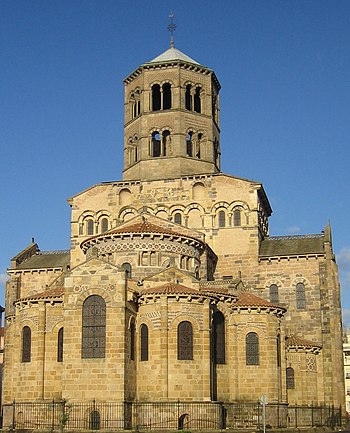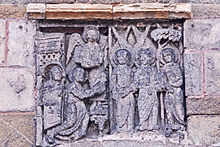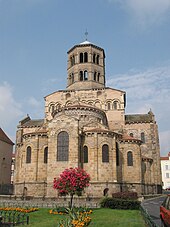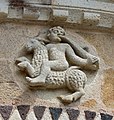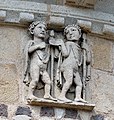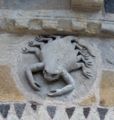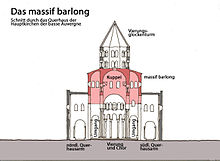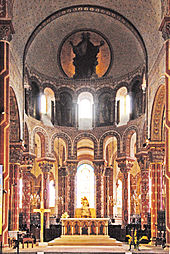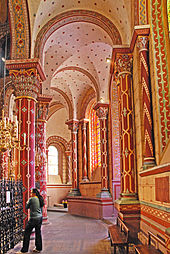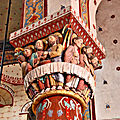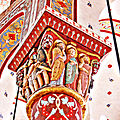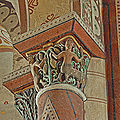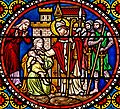St-Austremoine (Issoire)
The former Benedictine abbey church Saint-Austremoine is located in the French town of Issoire in the region Auvergne Rhône-Alpes in the Puy-de-Dôme on the River Allier and 37 kilometers south of Clermont-Ferrand .
Saint-Austremoine is one of the six main churches of the Romanesque Auvergne building school in the Basse-Auvergne ( Limagne ), a landscape around the city of Clermont-Ferrand . These are the churches (in order of size): Saint-Saturnin , Saint-Nectaire , Notre-Dame d'Orcival , Notre-Dame-du-Port de Clermont-Ferrand , Mozac , and Saint-Austremoine d'Issoire . The mother church of this style was the pre-Romanesque cathedral of Clermont-Ferrand , which had to give way to a new Gothic building. These churches have many similarities, so it can be assumed that they were created by the same master builder.
St-Austremoine d'Issoire is the largest and most complete of these main churches. Her exterior is more adorned than that of any other. The Issoire construction project was of great importance and appears to have been completed in a single execution campaign without any interruption. In the west building alone, in the narthex , you can find remains of masonry from an older church, which is said to have been a vestibule for a longer period of time.
history
The Gallo-Roman Iciodurum goes on a foundation of the Celtic tribe of the Arverni back. It was also called Isiodorens and later for a long time - until the Revolution - it was written Yssoire .
Saint Stremonius or Stramonius (French: Saint Austremoine or Austromoine ) was one of seven bishops who are said to have been sent from Rome to Gaul by Pope Fabian (* before 200--20 January 250) in the middle of the 3rd century , to preach the gospel. According to Gregory of Tours , that should have been after 250. According to current research, the area was not Christianized until the 4th century.
Saint Austremoine was the first apostle of Auvergne and the first bishop of Clermont . During the lifetime of Gregory of Tours (538/39 to 594) his tomb was in Issoire . Gregory reported that the deacon Cautin , whom he knew personally and who later became Bishop of Clermont , revived the veneration of the forgotten saint and decorated his tomb.
The relics of Saint Austremoine were probably transferred to Volvic by Avis II , Bishop of Clermont , around 675-690 and reburied next to the tomb of Saint-Praejectus , who was his predecessor. Around 848 there was another transfer from Volvic to Mozac in the presence of a King Pippin , probably Pippin II of Aquitaine (* probably 823; † after 864 in Senlis ).
The Issoire monastery is very old. In a text from the 9th century, the Vita prima Austremonii , it is said that its foundation goes back to Saint Austremoine itself. This claim is unlikely, but can be seen as an indication of old age.
In the 10th century, the monks of the Benedictine Abbey Charroux in Poitou (founded in 785), who had fled with their relics from the Normans to Pierre-Encize (Saint-Yvoine) in Auvergne , restored the monastery of Issoire. They brought with them the reliquary of the skull of Saint Austremoine that was supposedly given to them by Roger of Aquitaine .
Under the episcopate of Bernhard, Archbishop of Clermont around 940, Abbot Gilbert had a basilica mirae magnitudinis , "a basilica of sublime size", built. This information was passed down through a document from 1197, which reports that Mozac recognized the relics of St. Austremoine due to disputes between the two abbeys. This church was probably the predecessor of the current one.
There is no written evidence of the time when today's church was built. However, it is commonly dated to the second third of the 12th century (between 1133 and 1166).
The pilgrimages to Santiago de Compostela in northern Spain began towards the end of the 11th century . Its greatest heyday was in the first half of the 12th century when hundreds of thousands of pilgrims traveled south every year. The Way of St. James in France was made up of four main routes and a network of numerous secondary routes. Numerous new churches, monasteries, hospices, hostels and cemeteries were built along these paths; existing facilities were expanded to meet the new requirements. For a pilgrimage church, above all, large areas of movement were needed for the numerous pilgrims , such as the ambulatory and side aisles , galleries and as many chapels as possible for the presentation of relics and their veneration.
As with the other main churches of the basse Auvergne (northern Auverne), the strong development of pilgrimages to Spain and the hoped-for income was the reason for the building of such a pilgrim church in Issoire, which is on an important secondary route between the main routes Via Lemovicensis and the Via Podiensis , which started from Nevers and opened up the whole of Auvergne and continued south. It was built in the prime of these pilgrimages.
The monastery of Issoire must have been quite wealthy even before the pilgrimages, because the large extent of the building project with an outer length of at least 70 meters could hardly be explained otherwise.
Since there is nothing to indicate an interruption or resumption of construction on this structure, it is assumed that the construction project was carried out and completed in a single execution campaign without interruption. However, this does not rule out that parts of the previous building were initially still available to pilgrims for church services and reliquary worship during the construction work. When erecting the new structure, as with almost all of the main churches in the east, the crypt and the choir head began and construction was then continued in sections via the transept and nave to the west building with narthex and finished there. The completed sections were made available to the pilgrims for use and at the same time the previous structure was also dismantled section by section. This procedure ensured the monastery chapter uninterrupted participation in the high willingness of the pilgrims to donate, especially to finance their building projects such as the new pilgrimage church and the maintenance and considerable expansion of the convent buildings.

When the quarrels between France and England over Aquitaine began after the middle of the 12th century , the pilgrimage declined. The later wars of the 13th and 15th centuries Century, such as the Hundred Years War (1339-1453), brought a dramatic slump and led to an almost complete cessation of the streams of pilgrims to Spain. Accordingly, after the completion of its pilgrimage church, the chapter of Saint-Austremoine could no longer partake of the donations made by the pilgrims. All that remained was the income from regional pilgrimages.
The church was only mentioned in documents at a time when it was almost lost forever. Shortly before the beginning of the Wars of Religion (1562–1598), in 1540, part of the population of Issoir converted to the Protestant faith and the city was drawn into the maelstrom of the Wars of Religion.
In 1574, Captain Merle , who was in the service of the Huguenots, seized the town and its monastery. The monks were massacred and the monastery ransacked. In order to collapse and set fire to the church structure, whose splendor bothered the Protestants, a pillar at the capital was supported with wooden stakes and the pillar base was knocked out. The stakes were then set on fire. But this venture was unsuccessful. The two towers of the church were then torn down so badly that they eventually collapsed. The capitals inside the church had also suffered from the occupation of Merle and his men. Some of them were severely damaged. They are said to have been repaired with plaster in the 17th century.
Ironically, the town and monastery were destroyed two years later when they were retaken by Catholic troops. However, Saint-Austremoine was largely spared.
In a print, which was probably made in the 18th century, before the French Revolution (1789 and following), the entire complex of the monastery is shown in a panoramic perspective from the east. On the south side of the church, extensive one to three-storey wings of the convent building extend in a right-angled arrangement to each other, which enclose three large courtyards. The courtyard, which adjoins the church, is framed by a cloister on the ground floor. On the east side of the building complex there is a large rectangular park, which is structured by a right-angled network of paths. The monastery buildings, courtyards and the park are enclosed by a high defensive wall with an inner battlement. The Allier flows past the southern defensive wall .
When the graphic was created, the towers above the crossing and the western building, which collapsed in 1574, were obviously no longer there. They should only be "reconstructed" in the 19th century. The graphic artist may have made it up. In contrast, the structure of the choir part almost corresponds to the version still preserved today. Only the height of the choir clearly exceeds the height of today's massif barlong . The towers shown could also have actually existed, which perhaps were built towards the end of the 16th century and then lasted for about 270 years. (See also graphic by Viollet-le-Duc.)
During the revolution ecclesiastical institutions were looted in Issoire, but the church was largely spared. The extensive convent buildings were sold as "public property" for demolition. To the south of the church there is still a rectangular square that is surrounded by multi-storey buildings that are reminiscent of the former convent buildings. The former park is now a large parking lot.
In 1830 the capital sculptures are said to have been repaired a second time - but with stucco.
In 1832 the church was placed under protection as a historical monument . This resulted in extensive restorations that barely meet the standards of today's conservators. In 1845, the facade of the west building was largely redesigned in a very sober way. At the same time, the square facade tower was restored in "pseudo-Romanesque" style. The eight-sided two-storey crossing tower was renewed in the same style in 1847. In the period from 1857 to 1859, the roof areas were covered with gray slabs of volcanic rock, as in other main churches. Likewise in the 19th century the southern transept chapel was probably renewed based on the model of the northern one.
Around the same time, the controversial painting of the interior of the church took place under the direction of Anatole Dauvergne , which scares unprepared visitors. At the time, it cost 60,000 gold francs. Even if you realize that almost all Romanesque churches were originally painted in color, it was certainly not in this garish way. In any case, the church never looked like it does today.
A letter from the well-known restorer Aimon-Gilbert Mallay (1805–1883) to the writer Prosper Mérimée (1834–1870) tells us that “the capitals are partly made of putty” (probably the plaster of paris from 1830). Mallay was a third restoration of Kapitellskulpturen using Roman cement (also Roman cement perform). As a result of the three restorations, the details of the capitals can no longer be regarded as purely Romanesque. Its basic concept alone shows that the capitals of Issoire were originally of very high quality.
A print by Eugène Viollet-le-Duc - dated 1856 - shows the current height and structure of the choir head. However, as in the older graphic mentioned above , the massif barlong has been increased in the middle area by a floor plan with a rectangular floor plan, which is at the height of today's first tower floor. On the east wall of this storey you can see a triangular contour that marks the connection of the previous higher roof of the choir. Above the second floor of the massif barlong follows an octagonal tower floor at the height of today's second tower floor. The spire has the shape of an octagonal pyramid, which, however, is steeper than it is today and no longer corresponds to Romanesque helmets.
However, the graphic can only show a state before 1847, when today's two-story tower was reconstructed. Together with the older printmaking, it shows that after the two towers collapsed in 1574 and before the current four-tower was erected in 1847, the church had a second floor of the massif barlong , which by no means corresponded to the original Romanesque version. Both graphics show that the head of the choir towered higher in the same period than it was originally and today.
In current restorations at the beginning of the 21st century, the main focus was on reworking the outer parts of the choir head. The roof coverings with gray volcanic stone slabs that were put on in the middle of the 19th century were reversed and replaced with roofing made of red monk and nun tiles . Presumably this will soon be done with the roofs of the nave and transept.
Building
Dimensions approx., Without pillar templates
Taken from the floor plan and extrapolated
- Total length (outside): 69.30 m
- Length of nave, between narthex and transept: 32.40 m
- Width of the nave (outside): 18.80 m
- Width of the nave (inside): 16.90 m
- Length of the west building (outside): 24.00 m
- Width of the west building (outside): 8.50 m
- Length of transept (outside): 31.50 m
- Overhangs transept arms (outside): 6.50 and 5.90 m
- Width of transept (inside): 7.60 m
- Overhangs west building: 2.10 m and 3.10 m
- Height of central nave: 18.80 m
- Height of the choir: 14.90 m
- Height aisles: 9.60 m
- Crossing dome height: 23.30 m
Outward appearance
The builders used the light arkose from Montpeyroux (Puy-de-Dôme) , a sandstone that takes on a nice warm tint in daylight. It is recognizable after the most recent restoration of the choir head. The other components, especially the long sides, now have dark tones caused by weathering. The wall bond consists of medium-sized stone , carefully hewn in a fern frond pattern . Several different stonemason's marks mark the individual stones, especially on the eastern main apse. As is customary in Limagne , parts of the masonry consist of small-format filler stones, such as the massif barlong .
Narthex / west building
Today's rather simple design of the west facade and the west tower is mainly due to the restorations of 1845. The west building is a kind of western transept that closes the nave of the nave in the west. The central tower of the west building, which is almost square in plan, is about the same width as its two arms. In the upper quarter of the cross arms on the facade and on the two head sides of the arms, the wall surfaces recede by around 25 centimeters. In these areas, a meter-wide wall pillars remain on the component edges, the outer sides of which are flush with the lower wall surfaces. They are led up to a meter below the upper end of the cross arms. On the horizontal recesses in the wall, in the middle of each of these wall niches, there is a slender, round-arched window, the wedge-shaped arch of which is covered by a cantilever profile with a simple roller frieze, which also swings horizontally at the ends of the arch and extends up to the wall projections.
The upper ends of the west transverse arms consist of defensive attics , which are covered with wide cantilevered cornices and which are supported by chipboard bricks . The vertical visible edge of the cornices is decorated with a multi-part chessboard frieze . Behind the Wehrattiken there are flat sloping roof surfaces that divert the rainwater all around into accessible rain gutters, which is led to the outside via a gargoyle on each end. In the eastern corner of each of the western transverse arms there is a spiral staircase that leads from the ground floor to the roof area and is closed at the top by a small housing with a gable roof cover.
On the ground floor there is a three-aisled closed narthex behind the facade into which the central main portal and two windows to the side open. The round arched main portal is framed by an archivolt , the arch of which is made from a strong round rod and inserted into a corresponding wall recess. It stands freely on all sides on smooth pillars, which are equipped with plant-carved capitals, simply profiled fighters , bases and angular plinths . The reveal edges of the portal emerge behind the archivolt . The archivolt arch is covered by a sharp-edged wedge arch, which is surrounded on the outside by a cantilever profile with a roller frieze. This profile ends on a horizontal cantilever profile, which is continued from the fighters of the main portal to the windows. The main portal has a wooden door, the wings of which are decorated with artfully forged hinges.
The arched windows on both sides of the portal illuminate the aisles of the narthex. Their sharp reveal edges are set back on all sides and extend to the floor. The inner wedge arch is covered by an outer sharp-edged wedge arch. The arch ends stand on cantilever profiles, which are taken over from those of the portal and carried on a good bit further on the outside of the windows. The outer arch is enclosed by a cantilever profile with a roller profile.
A slender, arched window is cut out axially above the main portal, the outer apex of which lies at the level of the horizontal wall setbacks of the west transverse arms. An archivolt with a sharp-edged wedge arch, which stands on pillars, which are equipped with simply carved capitals, profiled fighters, bases and angular plinths, is inserted in an upper and lateral wall offset. The sharp edges of the soffit of the window opening are slightly indented opposite the archivolt.
A bit above the window above there is a blind archivolt in a wall niche, the shape and width of which correspond to those of the window, although they are slightly lower. The only thing missing is the window opening. Its fighter profiles are level with the cantilevered cornices of the west transverse arms and are led up to them.
The closed base of the west tower closes on the top with a cantilever profile that is approximately at the height of the nave ridge. The west and east walls of the tower are flush with the west and east walls of the lower west building. The two tower floors are about the same height as each other and are separated by a cantilever profile that corresponds to that of the tower base.
On each outer wall of the lower tower floor, three slender arched arcade openings are cut out, the so-called sound arcades of the bell chamber. They are separated from one another by pillars that are about as wide as the openings in the arcades. The pillars on the component edges are a little wider. The arcade openings are covered by wedge stone arches that stand on pillars and the inner reveals. The columns, which are set back from the wall, have simply carved capitals, profiled fighters, bases and angular plinths. The transom profiles are guided over the pillars. The wedge arches are covered by cantilever profiles with roller friezes and end on the transom profiles.
The acoustic arc of the upper floor of the tower corresponds almost to that of the lower floor. Instead of just one arcade each, there is a twin arcade that is slightly wider than the lower one. The separating pillars are a bit slimmer and the columns are missing in their setbacks. The double wedge arches stand together on the inside on a pair of twin pillars and on the outside on the opening reveals and their fighters. The columns are equipped like those on the lower floor.
The upper tower floor is closed off by the projecting eaves of the tower spire. A simple eaves cornice made of horizontal stone slabs is supported by planed chipboard bricks, as can also be found on other eaves of the building. The wooden spire in the form of a flat inclined pyramid is covered by red hollow bricks in Roman format, which are also known as monk-nun bricks . Their lower row protrudes slightly over the eaves.
Longhouse
A single large gable roof, inclined at around 25 degrees, covers the three nave naves and rests on the vaulted caps without an actual roof structure. Around the middle of the 19th century, the original roof covering made of red hollow tiles in Roman form was replaced with dark stone slabs from Volvic. A comparable intervention in the preservation of monuments in the 19th century has already been reversed at the Notre-Dame du Port church in Clermont-Ferrand. The eaves overhang of the roof are wide. The Traufsparren rest on a cornice of horizontal stone slabs, which by no less expansive shaving-corbels is supported. The vertical visible edge of the cornices is decorated with a multi-part chessboard frieze . The lower rows of the tiles of the roof cladding protrude slightly over the cornice tiles and allow the rainwater to drip off freely. The ridge is crowned by a stone roof ridge , which has been preserved here in its original form. One can take a closer look at the shape of these roof ridges on the lower roofs of the choir and its chapels.
The side walls of the nave are very elaborately structured and carefully executed. They are divided horizontally into two floors, the lower corresponds to the ground floor and the upper to the gallery of the aisles. Seven large blind arcades take up the vertical yoke structure of the ships. The yokes and arches are separated by rectangular wall pillars, which are the same width and reach up almost the entire height of the wall. Their steeply sloping tops end just below the corbels of the eaves. Below the beginnings of the slightly stilted blind arches, which are marked on the side by transom profiles, the wall pillars 3 and 5 (from the west) are somewhat more expansive and function as buttresses . The other pillars 1, 2, 4 and 6 remain flush with the masonry of the blind arches and their gussets and must therefore be interrupted in this area.
In the upper area of the arcade niches, with the exception of the fifth yoke, large, arched window openings with sharp-edged reveals are left open. Its wedge stone arches are covered by a geometrically ornamented cantilever profile with a simple semicircular roller frieze, which continues horizontally at the height of the arches and is led up to the wall pillars. The arcade niches are delimited at the bottom by equally deep plinths that mark the height of the inner floor.
In the fifth yoke on the north side, the arched north portal with sharp-edged reveals is cut out. It is covered by a wedge arch, which is covered by a cantilever profile, which is accompanied by a kind of tendril or leaf frieze. About half a meter above there is a horizontal cantilever profile with two simple grooves. In the upper area of the arcade niche, a cantilever profile with a roller frieze runs horizontally at the same height as in the neighboring arcades.
Immediately above the north portal there is a rectangular relief depicting three standing people, the middle one with a cross nimbus is Jesus, the outer ones with nimbs are probably two of his disciples. The one on the left holds two fish in his hands, the one on the right a circular structure, presumably bread. Jesus speaks with outstretched arms, with his right hand he gives the gesture of blessing. This scene is obviously about "The first wonderful multiplication of bread" (Joh. 6, 2-14; Luk. 9, 11-17; Mark. 6, 33-46; Matth. 14, 13-23)
In the fifth yoke on the north side there is only in the arched area the horizontal cantilever profile with roller frieze that has been adopted from the neighboring windows. Since there was a large courtyard on this side of the church before the revolution, which was surrounded by a cloister and other convent buildings, there must have been access to the church here as well. It is obvious that this entrance was in this yoke without a window.
The upper floor begins at the level of the outer vertices of the wedge arches of the ground floor arcades. The walls between the wall pillars recede slightly there. The setback is covered with stone slabs, the outer edges of which are bevelled. In each of these wall sections, a triple blind arcade is embedded flush with the surface, which is slightly narrower than the distance between the pillars. Three sharp-edged wedge stone arches stand on four pillars, which are equipped with capitals carved with vegetal and wickerwork, profiled warriors, bases and angular plinths. The transom profiles of the outer pillars are brought up against the wall pillars. The wedge stone arches are covered by a cantilever profile with a simple roller frieze, which swings horizontally over the transom for a short time and is led to the pillars. The apex of these profiles extend to about 25 centimeters below the planed chipboard crags of the eaves. A very narrow, arched window with sharp-edged reveals is cut out in the central blind arcade.
In the corner between the south wall of the nave and the south arm of the transept, a small building on the ground floor was added, the use of which is not evident from any of the available sources. It is probably a sacristy with a cellar and accessed via a door from the south aisle. It is as wide as the seventh yoke and as long as the transept overhang. Its free roof edges are equipped with a cornice on chipboard bricks, as with the longhouse eaves. Behind this is a very flat sloping roof that makes the window in the aisle a little smaller. A round arched window is cut out in the south wall, similar to the windows of the nave, also with their overlapping. The window and the cornices indicate a very early execution, a little later than the construction of the church.
Transept with “massif barlong” and crossing tower
The transept arms have the same eaves, eaves heights, roof coverings and roof ridges as those of the nave roof. The corners of the transept arms are set back slightly on both sides of the wall and reinforced by strong, rectangular buttresses over the entire height of the wall. The eaves cornice of the transept arms with the planed chipboard corbels is led around the component edges on the south gable and extends over the entire width of the gable wall. With the north gable, the cornice is interrupted at the edges. Above this, in the extension and width of the gable wall, rises another piece of gable wall, which is closed off by the gable triangle. Its sloping upper sides rise just as inclined as the roof surfaces behind it and are covered by flat stone slabs that swing horizontally inwards at the end of the slopes. Their outer edges are decorated with a simple roller frieze. In the gable fields, triple blind arcades are embedded in the center, which are built up similar to the triple arcades of the nave. The pillars are, however, much shorter. The middle arch on the north gable is exceptionally shaped like a half quatrefoil. The wedge stone arches of the triple arcades are covered by the already known cantilever profile with a simple roller profile, which swings horizontally on the outside and hits the cover of the gable slopes. In the gable triangle above the above-mentioned overlapping, three individual so-called incrustations are embedded, these are stone mosaics made of mostly white and black stone plates, combined to form various geometric patterns. Here there are two squares and a larger triangle, in which a larger rosette is inserted approximately in the middle, which is surrounded by a grid of triangles. Its origins are by no means oriental, as is sometimes assumed, but Gallo-Roman or early Christian. The gable ridges are each crowned with a flat rectangular stele, to which a square, wide-ranging "paw cross" is superimposed in the upper area, a modification of similar crosses of the other main churches, such as the Notre-Dame-du-Port de Clermont-Ferrand .
The large, high wall area between the buttresses is divided horizontally into about two thirds of its height with a narrow cantilevered cornice that lies on a double supporting arcade, the surface of which is just behind that of the buttresses. The arch stones of the two arcades merge laterally into the buttresses and stand together in the middle on a sturdy three-quarter-round column, in front of a very flat wall pillar, equipped with a vegetable-carved capital, with a sprawling fighter plate. The two larger windows are recessed centered in the arcade niches, and so high that the lateral distance between the reveal edge and the buttress remains the same between the window arch and the arcade arch. This area between the arcades and the window arches is decorated with incrustations that are flush with the surface. In the wall niche above there are three somewhat smaller windows on the above-mentioned cantilever cornice. Your arch stones are covered on the outside by the well-known cantilever profile with roller frieze.
On the gable wall of the northern arm of the transept, a bas-relief is embedded just below the two windows, which is covered by a cantilever profile. The reliefs are already badly weathered. The left is rectangular and depicts the Lord's visit to Abraham with the three men symbolizing the Trinity. ( Gen 18 EU ) The right half of the relief is occupied by three standing people with wings and nimbuses, the middle one with a cross nimbus (the Lord) and a book on the left. They stand under the aforementioned terebinth ("tree of the Bible"), or giant oak. In the left half, Abraham (with a halo) steps out of his hut (or tent) and falls on his knees, offering a meal with his arms outstretched. His wife Sara is probably standing behind him, with a slaughtered animal in front of him. The role of the standing angel above Abraham is unclear.
The right relief is almost square and shows the sacrifice of Isaac , by Abraham, who gives his son, as the prophetic figure of redemption (first book of Moses, chapter 22). Abraham stands on the left (with a nimbus), in his raised right hand a knife, with his left hand he holds Isaac's head upright. He sits on a sacrificial table or a stack of firewood. On the right, the angel of the Lord announces that Abraham should forsake his intention and instead sacrifice the ram (bottom right).
The west sides of the transept arms are completely closed. On the east side of the upper half of the wall, two slender, round-arched windows are recessed, the wedge-shaped arches of which are covered by cantilever profiles with roller friezes that pivot horizontally at the arches. The semicircular apses of the transept chapels take up almost the entire width of the east walls. Their flat inclined half conical roofs are about halfway up the wall and are covered with red hollow tiles in Roman format. Their lower rows of bricks protrude slightly over the cornice panels of the eaves, which are supported by chipboard bricks. The vertical visible edges of the cornices are decorated with multiple roller friezes. The apse walls are divided into three sections by two half-columns. A small round-arched window is cut out in each of the central sections, the wedge-shaped arch of which is covered by a cantilevered profile with a simple roller frieze, which swings horizontally at the arches and runs around the entire apse to the transept walls. The wall sections above this cantilever profile are decorated with incrustations of black and white stone slabs, mostly with rosettes in circles. The southern transept chapel is a 19th century reconstruction.
The sections of space in extensions of the side aisles that extend up to the height of the crossing dome on the north and south sides of the transept, in the length of the width of the transept arms, take the external octagonal dome above the roofs of the aisles “in the pincer”. The outer surfaces of its east and west walls merge flush with the east and west facing sides of the octagonal tower base.
This structure is called massif barlong , which, together with the crossing dome, supports and supports the soaring bell tower. It can be found in all the main churches of the Basse Auvergne . In order to take the weight off this massive substructure, its walls and the windows located in them, also on the east side and across the crossing, were fitted with arcatures running through them, some of which contain smaller windows. Their arches are supported by pillars similar to those on the side walls of the nave. On the western side there is only one twin blind arcade above the side aisles. The middle part is covered by the upper part of the gable roof. The arcatures of the massif barlong are accompanied above their arch stones and below by cantilever profiles with the cantilevered cornice with roller frieze, like those in the nave windows, and horizontally connected to each other and led around the entire structure. On the east and west side above the arcades on both sides near the tower there is a round arched wall niche with a semicircular floor plan. On the east side, between these niches, incrustations are made, made of triangular mosaic panels, which are separated from each other and around the outside by narrow strips and bordered. The parts of the massif barlong that extend north and south of the tower are covered on the top with flat, outwardly inclined pent roofs, which are covered like the nave roof. The eaves formation is similar to that of the nave, but does not protrude as far. The rainwater also drips off freely here, but on the roofs below. Short sections of eaves can be seen above the aforementioned niches. They belong to small triangular monopitch roof surfaces that have arisen over the corners of the square crossing.
The crossing tower no longer corresponds to the Romanesque original, the two upper floors of which were torn in the Wars of Religion in 1574 and then completely collapsed. The current octagonal and two-storey crossing tower was rebuilt in 1847. In the period in between, around 270 years, the tower will not have remained in the collapsed state. The church could not have been used. The part of the convent building, which was very extensive and quite well preserved up to the revolution, indicates a certain prosperity of the monastery, which is confirmed by the graphic shown under "Historical". From this and the graphic by Viollet-le-Duc it can be concluded that there have been rather less successful interim experiments above the original massif barlong , which is close to today's. This also included an increase in the choir room. Obviously, the authenticity of the renewed components was not important at the time.
Although Saint-Saturnin was close, where the original tower with the massif barlong is still preserved today, and one could have glimpsed it there, more curiosities arose. This does not apply quite so extremely to the details of the two-story tower, which was later rebuilt.
The octagonal closed tower base is closed on the top by a rounded cantilever profile. The two floors are separated by a double cantilever profile. The upper one is slightly lower than the lower one. A twin arcade with slender openings is set in on each floor. The wedge stone arches stand on the outside in the lower storey on a column in a soffit recess, in the upper one on twin columns. The wedge arches stand together on a pair of pillars. All columns are equipped with capitals carved from plants, profiled fighters and bases on angular plinths. The wedge stone arches are covered by a cantilever profile with a simple roller frieze, which swings horizontally at the arches and extends to the corners of the tower. On the upper floor there are floor-to-ceiling three-quarter round bars in front of the tower corners. The tower is closed at the top by an eaves cantilevered on all sides made of cornice panels on chipboard bricks. A cantilever profile with a simple roller frieze runs directly under the corbels. The wall fields between the overlapping profiles of the wedge arches and a piece below the end profiles of the storeys are decorated in the width of the twin arcades with gridded incrustations in black, white and red, made of different geometric shapes such as squares, rhombuses , triangles and others.
The wooden spire in the form of a flat inclined octagonal pyramid is covered with bright zinc sheet on wooden formwork. It is crowned by a short round rod with a spherical pommel made of metal. From this a long pole rises high, the upper half of which is provided with a graceful wrought-iron cross. Above it, a weathercock turns in the wind.
The lack of sound lamellas in the arcade openings suggests that the tower no longer bells at least today. It can be assumed, however, that he owned bells in the past. This is also confirmed by the central passage in the crossing dome.
Choir head with chapel wreath
Certainly the most beautiful part of the church is its choir head, viewed from inside and outside. The lack of any nearby buildings allows an undisguised overview of these magnificent components. Here, as in the other main churches of the lower Auvergne, fundamentally different components, such as chapels, gallery, choir with its apse, transept, massive barlong and the renewed bell tower have been piled on top of each other with perfect mastery. In well thought-out gradations, the viewer's gaze wanders from the broad base of the wreath of small apses, over the constantly tapering components, up to the top of the tower. For this, the appropriate term " Auvergnatian pyramid " was coined.
The stone masonry of the choir head - made of (again) light arkose - shines today, after a restoration at the beginning of this century, in bright, clear colors, in different lively shades. In the arch stones of the windows one often encounters color changes, as in the case of the correct incrustations.
All roofs are covered with red hollow tiles in a Roman shape with a flat pitch, a reconstruction of the original roofing that was carried out during the above-mentioned restorations. For the conical roofs of the apses, the clay tiles were produced in different widths and tapered to obtain a clean laying pattern. The rainwater drips off freely on all eaves.
All the outer walls of the chapels and the ambulatory, between the chapels and their buttresses, stand on a wide, cantilevered, almost two-meter-high plinth that surrounds all of these components and is covered with flat, sloping panels. At the top chapel it is significantly flatter. In the case of the chapels and the walkway, this marks the height of the inner floor above the crypt. In the base, in the apses and between the chapels, small arched windows have been cut out to illuminate the crypt. The surrounding level is significantly lower here than in the other parts of the church, which at its western end rises almost to the inner floor level.
The four chapel apses have outer walls in the form of high stretched half cylinders that are flanged to the ambulatory. Their eaves height is slightly lower than that of the ambulatory. In contrast to the rest of the Auvergne, the floor plan of the apex chapel is almost square. It is believed that it was wedged between the two neighboring round chapels an indefinite period after construction began. The previous harmony of the ensemble of free-standing apses was not insignificantly disturbed.
The walls of the two apses next to the apse chapel are divided vertically by two three-quarter-round columns into three wall sections. The columns are crowned by simply carved capitals, without transom ends and stand on profiled bases. The capitals directly support the strong eaves cornice made of horizontally lying stone slabs, the vertical ends of which are decorated with a three-dimensional small chessboard frieze. They protrude significantly less than those of the nave. Their undersides are smooth. In the outer circumferential chapels, instead of the pillars, there are right-angled wall pillars with a steep slope on the top. They do not support the eaves and end under the top cantilever profile with a roller frieze. In all corners of the chapel connections to the walkway, there are right-angled wall pillars in the top sides, which are bevelled at corners. The cornice panels are supported by wood-chip corbels between the columns, and exclusively by these in the outer chapels. The walls under the corbels are closed off by a cantilever profile with a roller frieze.
The top chapel has only short free side walls and correspondingly short eaves that take over the height of the apsidal eaves. The flat head wall of this chapel is a gable wall, which protrudes slightly beyond the gable roof surfaces adjoining it and whose top sides, bevelled on both sides, take over the roof slopes. These are covered with flat plates which pivot horizontally inwards at their lower ends. Their visible edges are decorated with a roller frieze. The gable ridge is crowned with a "paw cross" that stands freely on a short base and its wide-spread arms form a square. These arms are held together by a larger circular ring. There is also a small circular ring in the center.
The arched windows of the chapels and the gallery are of different sizes. The 14 smallest are located in the chapel apses and in the side walls of the apex chapel, the four in the walls of the gallery are significantly larger. The largest window is in the gable wall of the apex chapel. The arch stones of the windows are covered by the well-known cantilever profile with roller frieze, which bend horizontally at the arches and are led around the chapels over the pillars. Because of the significantly higher arches of the windows in the gallery and in the gable wall of the apex chapel, the friezes that extend to the side are correspondingly higher and merge into the profile under the corbels of the chapels. The gussets on the side of the arches are filled with grids of incrustations of black and white diamonds and squares. Above the window of the apex chapel there is a larger structure of an incrustation in the gable triangle. Just above the Keilstein arch there are two circular incrustations with flower rosettes.
The roofs of the chapel apses have the shape of a gently sloping half cone. To avoid complicated penetrations of these roofs with the roof of the corridor, the outer walls of the chapels are bricked up higher and are closed on the top with triangular gables. Their tops are covered with smooth stone slabs, the protruding visible edges of which are partially decorated with a scroll frieze. The roof coverings of the chapels abut against these gables. Small gable roofs are arranged behind the gables, the roofs of which push radially against the rising walls of the choir apse and are crowned with stone roof ridges, like the one on the nave roof. The gable ridge is crowned with a broad paw cross (?), As in the radial chapel.
The roof of the radial chapel is a gable roof. This roof also comes up against a gable raised above the wall. The monopitch roof over the ambulatory begins with a rectangular floor plan. It continues around the choir apse in the same width. The five chapels interrupt the course of the eaves with the above-described, further raised pieces of the wall, with its gable tops. Between these gables and the choir apse wall, small gable roofs, with a trapezoidal plan, in a radial arrangement, interrupt the pent roof of the gallery. The eaves sections of the gallery are designed like those of the chapels.
The roof of the choir consists of a rectangle above the choir bay and a semicircle above the apse. The roof shape is accordingly composed of a gable roof and half a conical roof, the eaves of which are slightly lower. Both parts of the roof are separated by a wall protruding from the roof surface, which rises towards the center roughly like the pitch of the conical roof. In continuation of this gable wall, strong pillars protrude from the side choir walls. As with the gables behind the chapels, this gable has the same paw cross as that of the chapels. The eaves are designed as in the chapels, but with a significantly larger projection. The offset of the eaves is repeated in the eaves. The ridge of the gable roof is again crowned by a stone roof ridge.
The structure of the choir apse is divided into two horizontal sections, separated by a cantilever profile with the well-known roller frieze. In the lower section, five arched windows dominate, the arch stones of which are covered by double cantilever profiles, which bend horizontally at the height of the arches and continue to the next window. Strange rectangular niches remain between the lower and upper cantilever profiles, which are divided by three columns with carved capitals and profiled bases that directly support the upper cornice. This motif is borrowed from Roman antiquity. Outside the main churches, the motif can only be found once more at the not far away, round cemetery chapel of Chambon-sur-Lac .
The upper section of the choir apse wall, which is also known as the “architrave”, between the upper cantilever profile and the eaves cornice panels is entirely covered with incrustations of black and white mosaic panels. The lower section of the band consists of circular disks filled with rosettes. Above that there is a grid of small-format triangular panels.
On each of the walls of the choir bay, which extend beyond the roof, two twin blind arcades are incorporated, similar to those of the side walls of the nave in the gallery area, but here without any windows.
Sculpture of the signs of the zodiac (also constellations)
Bernard Craplet writes:
“In order to give expression to the ultimate meaning of this perfect complex, the Benedictine monks of Issoire placed the twelve signs of the zodiac as symbols of the order and complexity of the universe in a wreath on the chapels. They stand for a universe that in its entirety is the work of God. This idea is all encompassing. In the Middle Ages, the church was always viewed as a reduced image, as a microcosm within the macrocosm, in which the singing of the monks gave voice to the silent praise of creation. A similar zodiac adorned the interior of Clermont Cathedral in the 10th century. "
There are the following 12 constellations: Aries, Taurus, Gemini, Cancer, Leo, Virgo Libra, Scorpio, Sagittarius, Capricorn, Aquarius, Pisces.
The reliefs are applied to round, sometimes rectangular, base plates that are built into the walls flush with the surface. They are located above the windows of the chapels.
Gallery zodiac signs
Interior
Narthex / west building
The nave is preceded by the narthex typical of Auvergne . Due to the remaining remains of the previous church and the extensive restoration work of the 19th century, it is almost no longer recognizable.
The arch under which one enters the central nave is shifted over a meter to the south. It rests on fighters, the northern one of which is decorated with a braided ribbon . It is possible that when construction began in the east and the alignment of the building axis was measured slightly, which, given the great distance to the older components, later led to this rather large shift. In order not to make the shift of the central axis visible on the facade, the entire west building was then shifted to the south opposite the nave, so that its overhangs are 2.10 meters in the north and 3.10 meters in the south. But this is hardly noticeable from the outside.
The central room of the narthex shows at least part of the original condition, a remnant of the previous building from 940. It is covered by a barrel vault and accessed from a round arched opening in the main portal. Large round arched and sharp-edged passages lead into the side rooms, which are covered with groin vaults . The former round-arched passages to the side aisles were probably closed in the 19th century together with the other restoration work, resulting in chapel niches about two meters deep. There is a round-arched window in each of the west walls of the side rooms. In the east corners of the side rooms, door openings have been cut out that lead to the spiral stairs that lead to the roofs of the west transverse arms.
In the right room of the narthex there is a splendid fresco from the 15th century depicting the Last Judgment .
On the very high upper floor of the central section is the organ gallery, which has almost the same elevation as that of the adjoining central nave. A large niche is separated from the almost square floor plan of the room by a wall, which is not entirely taken up by the organ. There is an arched opening in the partition wall through which the rear of the organ can be accessed for maintenance. In the wall to the ship, an arcade opens, which is a little narrower than the ship, made of sharp-edged wall templates with simple transom finishes supported by a stilted belt arch. The gallery is separated from the ship by a wooden parapet that protrudes slightly. The window cut out on the west wall at the level of the organ does not help to illuminate the nave today. But that may well have been the case earlier, when the partition wall and an organ did not yet exist. The side rooms of the upper floor are connected to the side aisles by twin arcades just above the floor ceiling, but have no direct window openings in the outer walls. The galleries above the side aisles of the nave were accessed via differential stairs on the first floor of the side rooms.
Above the high first floors there are obviously second floors, of which the windows in the west transverse arms bear witness. In uncertain times, these rooms were probably used to accommodate people and to store supplies, firearms and projectiles, when the roofs of the western cross arms with their defense attics were used for defense purposes. From the rooms you can also reach the floors of the bell tower.
Longhouse
St-Austremoine has the widest central nave in the Auvergne at around 7.90 meters . The former pre-Romanesque cathedral of Clermont was a little narrower at around 7.70 meters, the Mozac Abbey Church came third with around 7.5 meters. The three-aisled nave comprises seven bays and has a two-storey elevation (cross-section) without a windowed upper aisle zone . Strong partition walls divide the ships, which are connected on both floors with large openings in the arcades .
The arcade openings on the ground floor are relatively slim at 3.86 meters but very high at 9.55 meters, and merge, as usual here, with the partition walls and groin vaults of the aisles. On the upper floor, the partition walls open to the galleries with twin and triple arcades.
The barrel vault above the central nave has a stilted and slightly pointed cross-section, a unique case for this type of building. This contour is barely visible, but this can be seen quite well from the course of the single belt arch between the third and fourth yoke. The girdle arch, which is rectangular in cross-section, is supported by two semicircular ministries , which are equipped with capitals carved from plants, profiled fighters and bases on angular plinths. Maybe he is just supposed to interrupt the baldness of the very long barrel. The two half-columns on the pillars between the fifth and sixth yoke pose another riddle. They only reach up to the height of the upper edge of the parapets of the arcades of the galleries , are equipped like the previous services, but have no overburden. It is believed that they once carried a wooden beam from which a wheel chandelier was hung to illuminate the church.
The pillar cores with a square cross-section each have three semicircular old services of equal height in front of them. Eight pillar cores give the central nave a smooth side that is flush with the inside of the partition wall. The four other pillar cores, each surrounded by four half services or columns, have a circular floor plan. These peculiar, ancient pillar changes can also be seen at the Notre-Dame-du-Port de Clermont-Ferrand or the Notre-Dame d'Orcival .
The services of the pillars are equipped with figurative as well as vegetable carved capitals, capitals, profiled fighters and bases on angular plinths. The transom profile is led around the entire pillar, with the exception of the four pillar sides facing the central nave, with the half-columns and services that are further raised.

The fourteen openings to the galleries, also known as triforias , are, with one exception, triplet markings, roughly the width of the high arcades on the ground floor. The fourteenth is a much smaller twin arcade in the north wall of the seventh yoke. They are separated by sharp-edged pillars that are as wide as the pillar cores below. The three arches in most of the openings stand on pillars equipped with carved capitals, profiled rectangular fighters and profiled bases on plinths. The outer arches merge into the partitions. Their arch approaches are marked by fighter profiles. The arches of the triplet markings are approximately at the level of the vault tabs. The arches of seven arcatures are semicircular, the other seven have the shape of half quatrains , they are also called cloverleaf. The openings with round and cloverleaf-shaped arcatures are irregularly distributed. The south side has six of the cloverleaf-shaped arcatures, the north side only one. Only in Notre-Dame-du-Port do you come across this beautiful shape and only on the south side. In Brioude it was later only used to decorate the ambulatory walls. The shamrock shape is found in many pilgrimage churches along the pilgrimage routes to Santiago de Compostela . The smaller exception of the openings in the seventh yoke with a twin arcade opens into a lower room originally vaulted with a trumpet dome, over which a staircase leads to the crossing tower.
The eastern arcade opens into the crossing and is as wide and equipped as the one between yokes four and five. It is covered by a sharp-edged stilted arch, the approaches of which are approximately level with the upper edge of the parapet of the gallery markings. He carries the western crossing wall. A triplet sarkatur opens in it, which is a little smaller than that of the central nave but has about the same equipment.
In the lower area of the west wall there is a centered round arched, sharp-edged blind arcade that is hardly narrower than the nave. A smaller round arched passage opens into the central space of the narthex, with fighters at the arches. It is shifted about one meter from the center to the south. The large opening to the organ gallery is described under Interior / Narthex.
Gallery central nave
The aisles are of remarkable beauty, broader than all the others, nearly ten meters high, and are well-lit through the arched windows in every yoke along the long side except the fifth. In the fifth yoke, the arched north portal is cut out on the north side, while the opposite outer wall is completely closed. There was probably an entrance to the former cloister here. In the seventh yoke of the south aisle there is a single-winged right-angled door to the sacristy. The yoke-dividing arcades from the opposite services and sharp-edged belt arches are just as high as those of the partition and are equally equipped. They have groin vaults that merge into the arches of the partition arcades. The arcades at the eastern head ends correspond to those dividing the yoke. In the lower area of the western end walls, a round arched arcade opened into the narthex, which is about half as high and as wide as the arcades dividing the yoke and is equipped like this. In modern times it was changed into a chapel niche with a set back partition. In the upper sections of the west walls a twin arcade opens, the arches of which stand in the middle on double pillars and are otherwise equipped like the triple arcades in the main nave.
Bernard Craplet writes in “Romanesque Auvergne” about the aisles: “If you consider the importance of the solemn processions in the medieval liturgy and imagine how the Gregorian processions passed through these splendid ships through which the monks of Issoire passed singing When the chants unfold, you inevitably start dreaming ” .
The interior of the galleries above the side aisles has the simple beauty of a cloister. Half a barrel vault supports the vault of the main nave and leans in the yokes against the partition wall, which is pierced by large openings. They are interrupted by partition walls in which round-arched passages are recessed. A round-arched window is cut out in each of the eastern head walls, and a passage into the western transverse arm in the western head wall. The galleries are illuminated through small, arched windows, each arranged in the middle of the yoke. There are six windows on the south side and five on the north side. Despite their spaciousness, the galleries were most likely not used for liturgical purposes. They can only be reached via the narrow spiral stairs in the west building and offer hardly any view of the ship and choir. However, it cannot be ruled out that the galleries, like the rest of the church, were available to the numerous pilgrims to St. James for overnight stays.
Gallery aisles
Transept with crossing
The builders of the lower Auvergne remained true to the otherwise generally abandoned motif of the old Carolingian candle arches over the crossing. They recognized the aesthetic design potential that slumbered in these huge wall arches. The dome with the crossing tower rests on them and through them the transept is not simply as usual, a ship that penetrates another, similar ship.
The flying buttresses of the crossing are large single arcades in the width of the central nave, at the height of the significantly lower choir vault. Above that, the crossing walls reach up to under the vaulted dome. In these walls there are triplet markings, each with two pillars and capitals, and two arched windows are recessed on the east side. The crossing is illuminated through these openings and windows. The four pillars of the crossing have the same square core cross-section as that of the central nave. They are dressed on all sides by semicircular services, which are crowned with carved capitals and profiled, wide-spreading fighters. The arches of the crossing standing on it are stilted, that is, their lowest two meters are initially vertical, up to the actual arch base.
The type of trumpet under the dome is remarkable . They usually serve to convert the crossing square into the shape of an octagon, on which the dome then rests. Trumpets consist of small round arches that frame a niche that is as uniform as possible. Here a flat console stone occupies the lower part. This could be an abutment of formwork girders when the dome was built. Perhaps it is also a clever solution to bridge the delicate transition between the niches and the crossing corners. In the top of the dome there is a circular opening for the vertical transport of bells, tools and building materials. Its height is 23.30 meters.
The two room sections on the north and south side of the crossing as an extension of the side aisles extend across the width of the crossing up to the height of the dome apex, and are covered there by half barrel vaults, the apex of which leans against the crossing. From below you can see a kind of huge housing floating above the empty room, which stands out wonderfully in the light of the afternoon sun, which flows in through the many high-lying windows. At the height of the trumpets alone, there are four large round-arched windows on the north and south sides of the crossing. The light cascades through this housing through the triple openings into the crossing, which then shines brightly. The abundance of light is supplemented by eight (!) Large windows each in the arms of the transept and the two windows in the east wall of the crossing. Plenty of light flows into the entire transept through at least 24 windows. This case appears particularly bright with the same windowing in the Notre-Dame-du-Port de Clermont-Ferrand after a recent restoration with almost white painting.
From the outside, the two “light housings” described above grasp the octagonal stump of the tower at the height of the dome like pliers . The whole thing looks like a rectangular substructure transversely under the tower, the so-called massif barlong , a peculiar component that only exists in the Auvergnatian building school.
The transept arms, which are extremely simple, similar to the central nave, protrude laterally over the nave and are covered by a barrel vault in the transverse direction to the central nave. As an extension of the aisle outer walls, the north and south outer walls of the massif barlong rise up. These stand on large individual arcades, corresponding in width and height to the opposite candle arches of the crossing. The arcade arch stands on flat pillars the width of the wall above, which has a simply profiled transom profile at the height of the arch, a detail that seems somewhat archaic here . This fighter profile is slightly higher than the fighters of the crossing arcades. The gable wall of the transept arm is enclosed by a large blind arcade, in the front view exactly corresponding to the arcade opposite described above. Within this large arcade, three large, arched windows with sloping walls are cut out in the upper area. Below is a group of three arcades, the arches of which rest on slender columns with carved capitals. Round-arched windows are left open in the outer arcades, a little larger than the upper ones. Your fabric edges have a setback. The middle one is a blind arcade. It is covered with a "triangular gable arch", again an archaic decor.
A semicircular chapel apse with a domed vault is housed in the east walls of the transept arms , the southern one is probably a 19th century reconstruction. Their openings to the transept arms are each flanked by columns in recesses in the wall, with sculpted capitals and profiled fighters and bases. A small arched window is cut out in each of the apse walls. They are covered by arcade arches, which are supported by slender columns, with the usual equipment. They stand on a pedestal that goes around the entire apse. The east walls of the transept arms are equipped with two windows, the shape, size and height of the upper windows on the gable walls.
For the transept, the harmonious gradation of the openings should be pointed out, starting from the chapel openings via the slightly higher passages in the ambulatory, to the high triumphal arch of the choir room.
Just before the triumphal arch to the choir and the passages in the ambulatory, a spacious five-step staircase leads up to the choir and the ambulatory. In this zone, two narrow stairs lead in opposite directions down to the crypt.
Choir head with wreath chapels
Here, too, the choir is the masterpiece of the Auvergnatian builder. Its whole architecture aims to draw the attention of the faithful to the altar, as the sacred place, as the most holy place. Last but not least, the size and complexity of the entire complex, including the handling and chapel wreath, and its particularly splendid decoration, significantly more abundant than in the central nave, as well as the large number of windows, there are at least 20. The figures and sculptures with the utmost care Leaf capitals are particularly prominent because their architectural environment is simply restrained.
The seven arcades of the choir apse are cut into the semicircular wall with sharp edges. They show carefully considered slight differences in their spacing. The middle one is somewhat broader than its neighbors, the outer ones being the widest. The arcades of the choir apse are heavily stilted, which means that their arch approaches only begin a good distance above their supports, the square fighter plates. As with the central nave arcades, the arcade arches are also the front arches of the groin vaults behind them. Due to the stilts, the apexes of the arcades come to the same height as those of the two semicircular, much wider arches of the side arcades of the choir bay.
The total of nine choir arcades stand on eight sturdy pillars, which are equipped with capitals, some with figurative sculptures, and profiled warriors and bases, directly on the floor. The side arcades of the choir cook are on the outside of the services on the crossing pillars, which are already known from the ships.
Above the arcades of the choir apse, which are lined up in a semicircle, rests a low strip of the smooth apse wall, which ends at the top with a recess in the wall. Behind it are the connections to the gallery vaults and their roofing. Above it stands a semicircular row of five arched windows with expanded walls, alternating with four pillars curved in plan, the inner sides of which form the recess mentioned above. The window openings are on the inside about as wide as the middle choir gallery. The middle window is in the center of the choir, the outer windows are arranged over the outer gallery arches of the apse, the two remaining windows are counted from the outside exactly in the middle between the outer windows and the middle one, or centered over the two third pillars. In front of the pillars between the windows are slender columns, slightly indented from the corners of the robes, equipped with carved capitals and profiled fighters. The arcade arches of the windows, which merge into the arches of their walls, rest on them. Blind arcades of approximately the same size are inserted between these arcades, flush with the surface and flush with the wall. Above this series of seven arches, the semicircular wall surface of the choir apse merges seamlessly into its semicircular dome.
The choir bay, between the triumphal arch and the apse dome, is vaulted with a strongly elevated round barrel, which is slightly lower and narrower than the adjoining apse vault. The side walls of the choir bay have no further openings above their arcade openings.
The ambulatory, in the apse in the form of half a circular ring is covered with a cleverly subtle Gratgewölbe that of the arcades of the choir apse and supported the outer walls of dealing, the latter supported by there before the walls of free-standing columns with carved capitals and profiled fighters and bases on plinths and stand on almost 1.50 meter high plinths. Slightly curved ridges were created in the individual trapezoidal vault segments. The four large windows in the gallery are flanked by slender columns in the back of the wall. They are equipped like the other pillars and stand on the higher inner parapets. The two windows in the first choir bay, at the entrance of the gallery that runs right here, are flanked on both sides with twin columns, equipped like the other tall columns, but with common striker plates and plinths standing on plinths of the same height. The windows of the gallery, as well as those of the chapels, have steeply inclined parapets, which are joined by brackets on the inside.
Four of the five wreath chapels each consist of a semicircular apse with a corresponding dome . In the apse walls there are three round arched windows. They are connected to one another by an arcature with slender pillars standing on a protruding wall around the apse, with the familiar full equipment. The top chapel stands on a slightly rectangular floor plan and is covered by a barrel vault. In the three free wall sections round-arched windows are cut out, which, like in the other chapels, are flanked by columns set back from the wall and how they are equipped. The middle window of the apex chapel is the largest of the entire choir head.
Capital sculpture
Choir capitals
Only four of the eight capitals of the apse are carved with narrative representations, the others with ornate foliage. The iconographic program doesn't offer the intricacies of Notre-Dame-du-Port de Clermont-Ferrand or Notre-Dame-du-Mont-Cornadore de Saint-Nectaire . It is only about the Easter cycle, from Maundy Thursday to the Resurrection. The first capital to the north shows the Lord's Supper. Opposite him, two stations of the Passion are depicted: the flagellation and the carrying of the cross. The center capitals are dedicated to the events of the Easter days, such as the visit of the holy women at Christ's tomb and the appearance of Jesus after the resurrection. This program forms a closed unit and has its right place around the altar, on which the mystery of death and resurrection is renewed at each celebration of mass.
Unfortunately, the sculptures are not preserved undamaged and have been painted with bright colors (see historical).
According to the French art historian Swiechowski , they are said to have come from a Provencal traveling workshop . The beautiful Last Supper capital is by far the most popular, especially because of its skilful composition and great artistry, which in its perfect lines can hardly be attributed to the naivety of folk art.
Gallery choir capitals. Passion of Christ
More capitals
The capitals of the nave are predominantly decorated with fine, very decorative foliage motifs of low relief. Here and there large flowers, birds, griffins, small heads or centaurs appear in the foliage. In the north transept chapel there are two remarkable capitals with figural motifs. On one of them a devil puts two damned people in chains. The second shows a man carrying a sheep on his shoulders and sticking out his tongue. This facial expression can often be found on the representations of the subject of the sheep-bearer, popular with Auvergnatian stonemasons, such as in Notre-Dame-du-Mont-Cornadore de Saint-Nectaire , Collegiate Church of Saint-Julien (Brioude) and others. He is also found among the vices or the devil's helpers who are conquered by virtues in Notre-Dame-du-Port de Clermont-Ferrand . The occasional interpretation of the sheep-bearer as a " good shepherd " is therefore unlikely to apply.
Gallery of other capitals
Stained glass
In the windows there is lead glazing with artistic glass paintings from the end of the 19th century. They tell about the life of St. Austremonius and St. Joseph.
Gallery stained glass
crypt
The choir head of St-Austremoine with its chapel wreath rests on a spacious semi-underground crypt. It can be reached via stairs on both sides of the eastern crossing piers. The painters of the 19th century spared this architectural work of art with their garish plaster paintings. Eight squat columns correspond to those of the choir apse and, like this, are enclosed by the ambulatory. In the middle, four additional columns arranged in a square support the floor of the chancel. The vault with a height of about 3.80 meters at the top consists of groin vaults except for four places. On these it has been replaced by large, flat, square stone slabs. Three of the five thick-walled wreath chapels have slightly rectangular floor plans on the inside, not only the apex chapel, but also the two outer ones.
In the west, under the wide staircase to the choir and between the access stairs, there are three almost square niches known as the Martyrion or Confessio . They were used to safely store relics behind lockable bars. They could usually also be viewed by candlelight through openings in the steps, the so-called fenestella , when the crypt was locked.
In the last century a small ornate enamel shrine from Limoges was installed there, which a priest of Issoire bought in the 19th century to keep the remains of the patron saint Saint-Austremoine . It depicts the holy women at the tomb of Christ and his appearance to Mary Magdalene, which suggests that it originally contained relics. Her drawing and colors are magnificent. The individual fields are only 17.2 × 9.6 centimeters in size. The shrine was probably made in the early 8th century.
With one exception, the floor plan of the crypt of St-Austremoine d'Issoire almost corresponds to that of Notre-Dame d'Orcival or Notre-Dame-du-Port de Clermont-Ferrand . Here a circle of at least 22 slender columns decorates the walls of the ambulatory. In the crypt, too, the Benedictines of Issoire Abbey wanted to surpass the older churches in splendor. A monogram was carved into the strong cover plate of one of the capitals on the south side that supposedly stands for AUSTREMONIUS.
literature
- Ernst Adam: Pre-Romanesque and Romanesque. Frankfurt 1968, p. 136
- Marcel Durliat : Romanesque Art. Freiburg-Basel-Vienna 1983, p. 483
- Hermann Fillitz : The Middle Ages I. (= Propylaea Art History Vol. 5. Frankfurt am Main - Berlin [1969] 1990), Fig. 169
- Hervé Kergall: Gothic cathedrals and art treasures in France. Eltville 1990. Fig. 81
- Marie-Claire Ricard: The Abbey Church of Issoire. Lyon 1988
- Ulrich Rosenbaum: Auvergne and Massif Central. Cologne [1981] 1989, p. 95, fig. 34,35,39, color plate 15
- Bernard Craplet: Romanische Auvergne , Echter Verlag, Würzburg 1992, pp. 110–116, ISBN 3-429-01463-8
- Rolf Toman (ed.): The art of the Romanesque. Architecture - sculpture - painting. Cologne 1996, p. 150
- Sylvie Jolivet: Issoire: Restoration of the décors de l'abbatiale . In: Le Moniteur des Travaux Publics et du Bâtiment , December 10, 2004
Web links
- Église Saint-Austremoine d'Issoire. In: Structurae
- La fondation de l'abbaye de Saint-Austremoine. In: Issoire.fr (French)
- Photos from Saint-Austremoine
- More photos from Saint-Austremoine
- History of Saint-Austremoine (French)
Individual evidence
Individual references refer to historical data, developments and connections. Architectures, their integration into the environment, outdoor facilities, artistic works of art and the like are evidenced by photos and graphics.
- ↑ Bernd Craplet, Roman Auvergne, Phenix-Echterdingen, Camellia Verlag; P. 111
- ↑ Bernd Craplet, Roman Auvergne, Phenix-Echterdingen, Camellia Verlag; Pp. 111-112
- ↑ http://architecture.relig.free.fr/issoire.htm
- ↑ Bernd Craplet, Roman Auvergne, Phenix-Echterdingen, Camellia Verlag; P. 112
- ↑ Bernd Craplet, Roman Auvergne, Phenix-Echterdingen, Camellia Verlag; P. 112
- ↑ Bernd Craplet, Roman Auvergne, Phenix-Echterdingen, Camellia Verlag; P. 112
- ↑ Bernd Craplet, Roman Auvergne, Phenix-Echterdingen, Camellia Verlag; P. 112
- ↑ Bernd Craplet, Roman Auvergne, Phenix-Echterdingen, Camellia Verlag; P. 112
- ↑ Bernd Craplet, Roman Auvergne, Phenix-Echterdingen, Camellia Verlag; P. 112
- ^ Julia Droste Hennings, Thorsten Droste, France the South West, Dumont Reiseverlag, Ostfildern 1st edition 2007,; P. 25.
- ^ Ulrich Rosenbaum, Auvergne and Massif Central, Dumont Buchverlag Cologne, 4. 1986 edition; P. 96
- ^ Ulrich Rosenbaum, Auvergne and Massif Central, Dumont Buchverlag Cologne, 4. 1986 edition; P. 96
- ↑ Bernd Craplet, Roman Auvergne, Phenix-Echterdingen, Camellia Verlag; P. 112
- ↑ Bernd Craplet, Roman Auvergne, Phenix-Echterdingen, Camellia Verlag; P. 112
- ↑ Bernd Craplet, Roman Auvergne, Phenix-Echterdingen, Camellia Verlag; P. 115
- ↑ Bernd Craplet, Roman Auvergne, Phenix-Echterdingen, Camellia Verlag; P. 115
- ↑ Bernd Craplet, Roman Auvergne, Phenix-Echterdingen, Camellia Verlag; P. 113
- ↑ Bernd Craplet, Roman Auvergne, Phenix-Echterdingen, Camellia Verlag; P. 113
- ↑ Bernd Craplet, Roman Auvergne, Phenix-Echterdingen, Camellia Verlag; P. 113
- ↑ Bernd Craplet, Roman Auvergne, Phenix-Echterdingen, Camellia Verlag; P. 114
- ↑ Bernd Craplet, Roman Auvergne, Phenix-Echterdingen, Camellia Verlag; P. 114
- ↑ Bernd Craplet, Roman Auvergne, Phenix-Echterdingen, Camellia Verlag; P. 114
- ↑ Bernd Craplet, Roman Auvergne, Phenix-Echterdingen, Camellia Verlag; P. 116
- ↑ Bernd Craplet, Roman Auvergne, Phenix-Echterdingen, Camellia Verlag; P. 116
Coordinates: 45 ° 32 ′ 36.8 ″ N , 3 ° 15 ′ 1 ″ E
